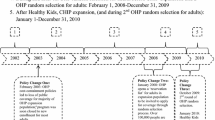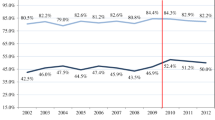Abstract
The objectives of this study were to (1) measure health insurance coverage and continuity across generational subgroups of Latino children, and (2) determine if participation in public benefit programs is associated with increased health insurance coverage and continuity. We analyzed data on 25,388 children income-eligible for public insurance from the 2003 to 2004 National Survey of Children’s Health and stratified Latinos by generational status. First- and second-generation Latino children were more likely to be uninsured (58 and 19%, respectively) than third-generation children (9.5%). Second-generation Latino children were similarly likely to be currently insured by public insurance as third-generation children (61 and 62%, respectively), but less likely to have private insurance (19 and 29%, respectively). Second-generation Latino children were slightly more likely than third-generation children to have discontinuous insurance during the year (19 and 15%, respectively). Compared with children in families where English was the primary home language, children in families where English was not the primary home language had higher odds of being uninsured versus having continuous insurance coverage (OR: 2.19; 95% CI [1.33–3.62]). Among second-generation Latino children, participation in the Food Stamp (OR 0.26; 95% CI [0.14–0.48]) or Women, Infants, and Children (OR 0.40; 95% CI [0.25–0.66]) programs was associated with reduced odds of being uninsured. Insurance disparities are concentrated among first- and second-generation Latino children. For second-generation Latino children, connection to other public benefit programs may promote enrollment in public insurance.

Similar content being viewed by others
References
Flores, G., & Vega, L. R. (1998). Barriers to health care access for Latino children: A review. Family Medicine, 30(3), 196–205.
Flores, G., et al. (2002). The health of Latino children: urgent priorities, unanswered questions, and a research agenda. The Journal of the American Medical Association, 288(1), 82–90.
Zambrana, R. E., & Carter-Pokras, O. (2004). Improving health insurance coverage for Latino children: a review of barriers, challenges and State strategies. Journal of the National Medical Association, 96(4), 508–523.
Flores, G., et al. (2005). Racial and ethnic disparities in early childhood health and health care. Pediatrics, 115(2), e183–e193.
Newacheck, P. W., et al. (1998). Health insurance and access to primary care for children. The New England Journal of Medicine, 338(8), 513–519.
Shone, L. P., et al. (2005). Reduction in racial and ethnic disparities after enrollment in the State Children’s Health Insurance Program. Pediatrics, 115(6), e697–e705.
Zambrana, R. E., & Logie, L. A. (2000). Latino child health: Need for inclusion in the US national discourse. American Journal of Public Health, 90(12), 1827–1833.
General Accounting Office. (1998). Medicaid: Demographics of nonenrolled children suggest state outreach strategies. Washington, DC: General Accounting Office; 1998 GAO/HEHS-98-93.
Ojeda, V. D., & Brown, E. R. (2005). Mind the gap: Parents’ citizenship as predictor of Latino children’s health insurance. Journal of Health Care for the Poor and Underserved, 16(3), 555–575.
Ku, L. (2007). Improving health insurance and access to care for children in immigrant families. Ambulatory Pediatrics, 7(6), 412–420.
Van Wie, A., et al. (2008). Persistent disparities in health insurance coverage: Hispanic children, 1996–2005. Journal of Health Care for the Poor and Underserved, 19(4), 1181–1191.
Flores, G., et al. (2005). How Medicaid and the State Children’s Health Insurance Program can do a better job of insuring uninsured children: the perspectives of parents of uninsured Latino children. Ambulatory Pediatrics, 5(6), 332–340.
Hill, I., et al. (2006). Do access experiences affect parents’ decisions to enroll their children in Medicaid and SCHIP? Findings from focus groups with parents. Maternal and Child Health Journal, 10(6), 517–525.
Burgos, A. E., et al. (2005). Importance of generational status in examining access to and utilization of health care services by Mexican American children. Pediatrics, 115(3), e322–e330.
Granados, G., et al. (2001). Health care for Latino children: impact of child and parental birthplace on insurance status and access to health services. American Journal of Public Health, 91(11), 1806–1807.
Blumberg, S. J., et al. (2005). Design and operation of the national survey of children’s health, 2003. National Center for Health Statistics. Vital Health Statistics, 1(43), 1–123.
Kaiser Family Foundation (2005) Income eligibility levels for children’s regular Medicaid by annual incomes and as a percent of Federal Poverty Level (FPL). Available at: www.statehealthfacts.org. Accessed October 1, 2005.
Kaiser Family Foundation (2005). Income Eligibility Levels for Children’s Separate SCHIP Programs by Annual Incomes and as a Percent of Federal Poverty Level. Available at: www.statehealthfacts.org. Accessed October 1, 2005.
United States Census (2006). Foreign-born population of the United States Current Population Survey - March 2006. Available at http://www.census.gov/population/www/socdemo/foreign/cps2006.html#gen. Accessed February 17, 2011.
Olson, L. M., et al. (2005). Children in the United States with discontinuous health insurance coverage. The New England Journal of Medicine, 353(4), 382–391.
Rao, J. N. K., & Scott, A. J. (1981). The analysis of categorical data from complex sample surveys–chi-squared tests for goodness of fit and independence in 2-way tables. Journal of the American Statistical Association, 76, 221–230.
Aday, L. A., & Andersen, R. (1974). A framework for the study of access to medical care. Health Services Research, 9(3), 208–220.
Stata, C. (2003). Stata survey data reference manual: Release 8. College Station, TX: Stata Corp.
Feinberg, E., et al. (2002). Language proficiency and the enrollment of Medicaid-eligible children in publicly funded health insurance programs. Maternal and Child Health Journal, 6(1), 5–18.
Lessard, G., & Ku, L. (2003). Gaps in coverage for children in immigrant families. Future Child, 13(1), 101–115.
Flores, G., et al. (2006). Why are Latinos the most uninsured racial/ethnic group of US children? A community-based study of risk factors for and consequences of being an uninsured Latino child. Pediatrics, 118(3), e730–e740.
Flores, G., et al. (2005). A randomized, controlled trial of the effectiveness of community-based case management in insuring uninsured Latino children. Pediatrics, 116(6), 1433–1441.
Satchell, M., & Pati, S. (2005). Insurance gaps among vulnerable children in the United States, 1999–2001. Pediatrics, 116(5), 1155–1161.
DeVoe, J. E., et al. (2008). “Mind the Gap” in children’s health insurance coverage: does the length of a child’s coverage gap matter? Ambulatory Pediatrics, 8(2), 129–134.
Aiken, K. D., et al. (2004). When insurance status is not static: insurance transitions of low-income children and implications for health and health care. Ambulatory Pediatrics, 4(3), 237–243.
Sommers, B. D. (2005). From Medicaid to uninsured: drop-out among children in public insurance programs. Health Services Research, 40(1), 59–78.
Federico, S. G., et al. (2007). Disruptions in insurance coverage: patterns and relationship to health care access, unmet need, and utilization before enrollment in the State Children’s Health Insurance Program. Pediatrics, 120(4), e1009–e1016.
Sommers, B. D. (2007). Why millions of children eligible for Medicaid and SCHIP are uninsured: poor retention versus poor take-up. Health Affairs (Millwood), 26(5), w560–w567.
Dorn S. (2009). Express lane eligibility and beyond: How automated enrollment can help eligible children receive Medicaid and CHIP. Washington, DC: The Urban Institute; April 2009. Available at: http://www.urban.org/url.cfm?ID=411879. Accessed April 7, 2011.
Cousineau, M. R., et al. (2007). Enrolling in Medicaid through the National School Lunch Program: outcome of a pilot project in California schools. Public Health Report, 122(4), 452–460.
Acknowledgments
The authors thank Drs. Glenn Flores and Celette Skinner for their comments on an early draft of the manuscript and Dr. Michael Steiner for his assistance throughout manuscript preparation.
Author information
Authors and Affiliations
Corresponding author
Rights and permissions
About this article
Cite this article
DeCamp, L.R., Bundy, D.G. Generational Status, Health Insurance, and Public Benefit Participation Among Low-Income Latino Children. Matern Child Health J 16, 735–743 (2012). https://doi.org/10.1007/s10995-011-0779-8
Published:
Issue Date:
DOI: https://doi.org/10.1007/s10995-011-0779-8




